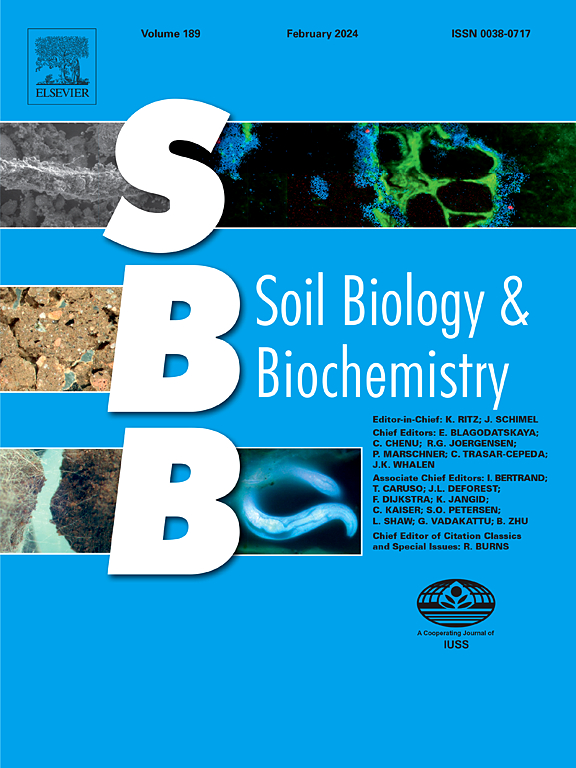Deciphering the microbial players driving straw decomposition and accumulation in soil components of particulate and mineral-associated organic matter
IF 9.8
1区 农林科学
Q1 SOIL SCIENCE
引用次数: 0
Abstract
Soil organic carbon (SOC) in terrestrial ecosystems is reliant mainly on plant-derived carbon (C) inputs. Although the contribution of plant straw to soil C accrual within particulate organic matter (POM) and mineral-associated organic matter (MAOM) has been widely investigated, the microbial groups responsible for driving straw decomposition and the allocation of C into POM and MAOM pools remains elusive. The main challenge is the ability to separate the soil fractions without severely disrupting the microbial community. By using ultrasonic energy (kept 80 J mL-1) and size fractionation, this study effectively isolated POM and MAOM with negligible impact on microbial community in two paddy soils (i.e., the Mollisol and Ultisol). The isolated POM and MAOM were subsequently mixed with C4 maize straw and incubated for 87 days to investigate straw decomposition and accumulation using natural 13C abundance and the underlying microbial community difference. This study revealed that: (i) mineralization of straw-derived C was significantly higher in the POM fraction compared to the MAOM fraction, whereas straw-C retention was concomitantly greater in MAOM; (ii) compared to bacteria, fungi contributed more significantly to straw mineralization in POM, likely due to their lower metabolic nutrient requirements and extensive hyphal interactions. In contrast, the interaction between Fe-OC, Ca-OC, and bacteria played a crucial role in facilitating straw-derived C stabilization in MAOM. This study reveals the microbial drivers involved in straw-C transformation within POM and MAOM by a proper separating approach and highlights the microbial mechanisms underpinning the fate of straw C in these two soil components.解读驱动秸秆分解和土壤中颗粒和矿物相关有机物成分积累的微生物参与者
陆地生态系统土壤有机碳(SOC)主要依赖于植物来源的碳输入。虽然植物秸秆对颗粒有机质(POM)和矿物伴生有机质(MAOM)中土壤C积累的贡献已被广泛研究,但负责驱动秸秆分解并将C分配到POM和MAOM库的微生物群尚不清楚。主要挑战是在不严重破坏微生物群落的情况下分离土壤组分的能力。本研究通过超声波能量(保持80 J mL-1)和粒度分选,在两种水稻土(Mollisol和Ultisol)中有效分离出POM和MAOM,对微生物群落的影响可以忽略不计。将分离的POM和MAOM与C4玉米秸秆混合培养87 d,利用天然13C丰度和微生物群落差异研究秸秆的分解和积累。该研究表明:(1)与MAOM相比,POM组分中秸秆衍生的碳矿化明显更高,而MAOM组分中秸秆衍生的碳保留率也更高;(ii)与细菌相比,真菌对POM中秸秆矿化的贡献更显著,这可能是由于真菌的代谢养分需求较低,菌丝相互作用广泛。相反,Fe-OC, Ca-OC和细菌之间的相互作用在促进MAOM中秸秆来源的C稳定中起着至关重要的作用。本研究通过适当的分离方法揭示了POM和MAOM中参与秸秆-C转化的微生物驱动因素,并强调了这两种土壤组分中秸秆-C命运的微生物机制。
本文章由计算机程序翻译,如有差异,请以英文原文为准。
求助全文
约1分钟内获得全文
求助全文
来源期刊

Soil Biology & Biochemistry
农林科学-土壤科学
CiteScore
16.90
自引率
9.30%
发文量
312
审稿时长
49 days
期刊介绍:
Soil Biology & Biochemistry publishes original research articles of international significance focusing on biological processes in soil and their applications to soil and environmental quality. Major topics include the ecology and biochemical processes of soil organisms, their effects on the environment, and interactions with plants. The journal also welcomes state-of-the-art reviews and discussions on contemporary research in soil biology and biochemistry.
 求助内容:
求助内容: 应助结果提醒方式:
应助结果提醒方式:


